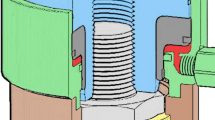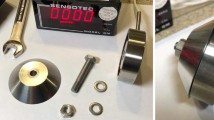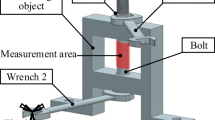Abstract
This paper presents an analysis of the assembly and disassembly processes for components in a bolted joint. The analysis shows a small amount of torsional elastic twist in joint components from applied torque during assembly and disassembly significantly affects thread and nut bearing friction. It reveals that after the assembly process, the nut bearing interface friction torque alone acts to counter not only the torque associated with bolt stretch, also known as the inherent self-loosening torque, but thread interface friction torque as well. Previous models and analyses of bolted joints have missed this point. Further, analysis of the disassembly process with applied removal torque reveals thread friction does not act to counter self-loosening and removal torque until sometime after nut bearing interface slip occurs. Only then do both thread friction and nut bearing friction counter self-loosening torque and removal torque. This is the state commonly assumed after the assembly process and for the duration of the disassembly process. The analysis presented reveals the effects of elastic twist of components in a bolted joint on thread friction and nut bearing friction and provides improved understanding of the state and behavior of bolted joints.












Similar content being viewed by others
Change history
16 January 2021
The placement of the subscripts in the first paragraph on the third page has been corrected.
References
VDI 2230, Systematic calculation of highly stressed bolted joints—joints with one cylindrical bolt. Verein Deutscher Ingenieure (2015)
J. Bickford, Introduction to the Design and Behavior of Bolted Joints, 4th edn. CRC Press (2008)
E. Oberg, F. Jones, H. Horton, H. Ryffel, Machinery’s Handbook, 25th edn. Industrial Press (1996)
G. Meyer, D. Strelow, Simple diagrams aid in analyzing forces in bolted joints. Assembly Eng. 28–33 (1972)
G. Kulak, J. Fisher, J. Struik, Guide to Design Criteria for Bolted and Riveted Joints. Wiley, Hoboken (2001)
R. Hibbeler, Mechanics of Meterials, 10th edn. Pearson (2016)
ECSS-E-HB-32-23A, Space Engineering Threaded Fasteners Handbook. European Cooperation for Space Standardization (2010)
J. Blake, H. Kurtz, The uncertainties of measuring fastener preload. Mach. Des. 128–131 (1965)
D. Hess, Preload from tightening and removal torque. J. Failure Anal. Prev. 19, 1055–1066 (2019)
Author information
Authors and Affiliations
Corresponding author
Additional information
Publisher's Note
Springer Nature remains neutral with regard to jurisdictional claims in published maps and institutional affiliations.
Rights and permissions
About this article
Cite this article
Hess, D.P. Effect of Component Twist on Friction in a Bolted Joint. J Fail. Anal. and Preven. 21, 669–677 (2021). https://doi.org/10.1007/s11668-020-01112-4
Received:
Revised:
Accepted:
Published:
Issue Date:
DOI: https://doi.org/10.1007/s11668-020-01112-4




